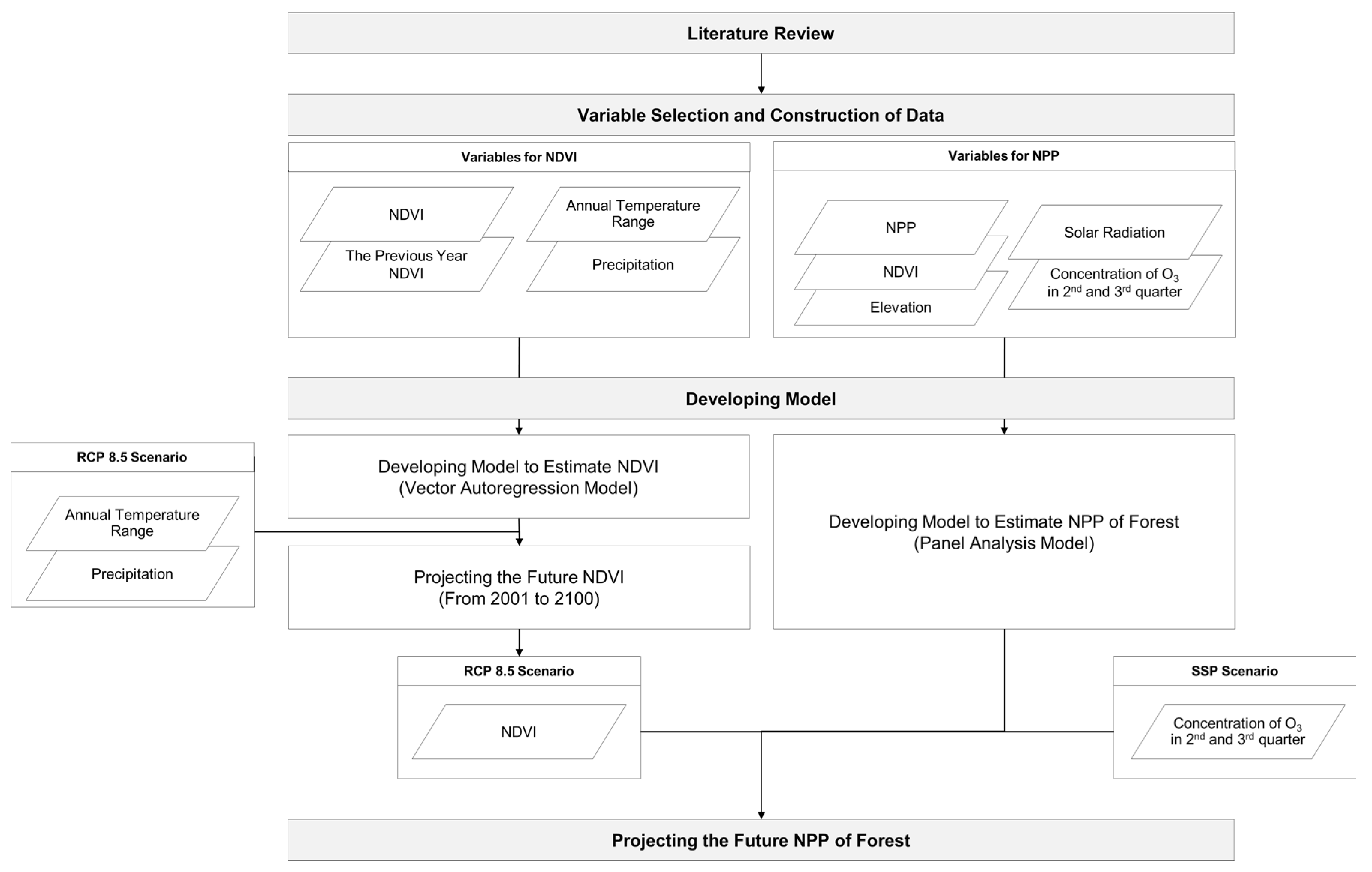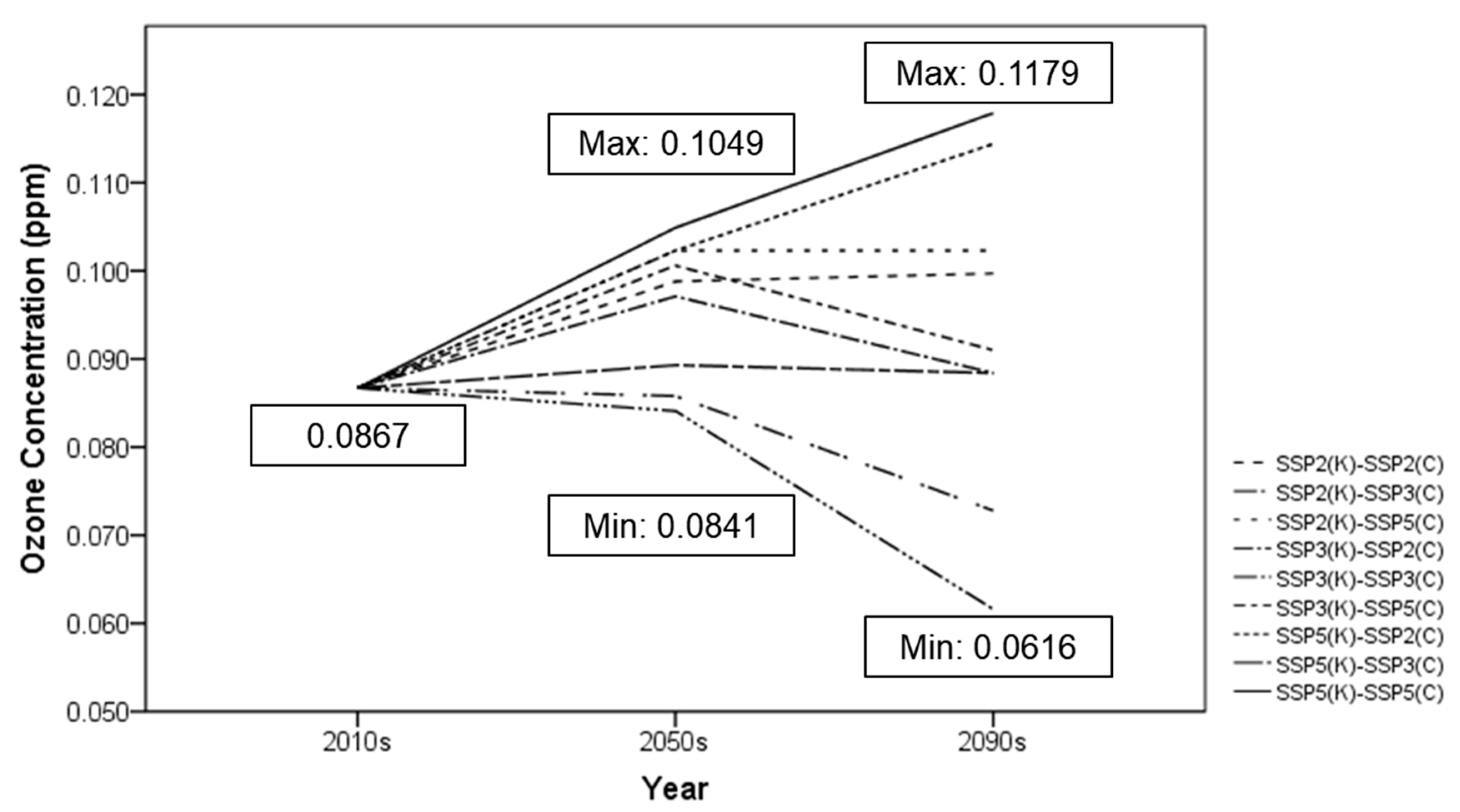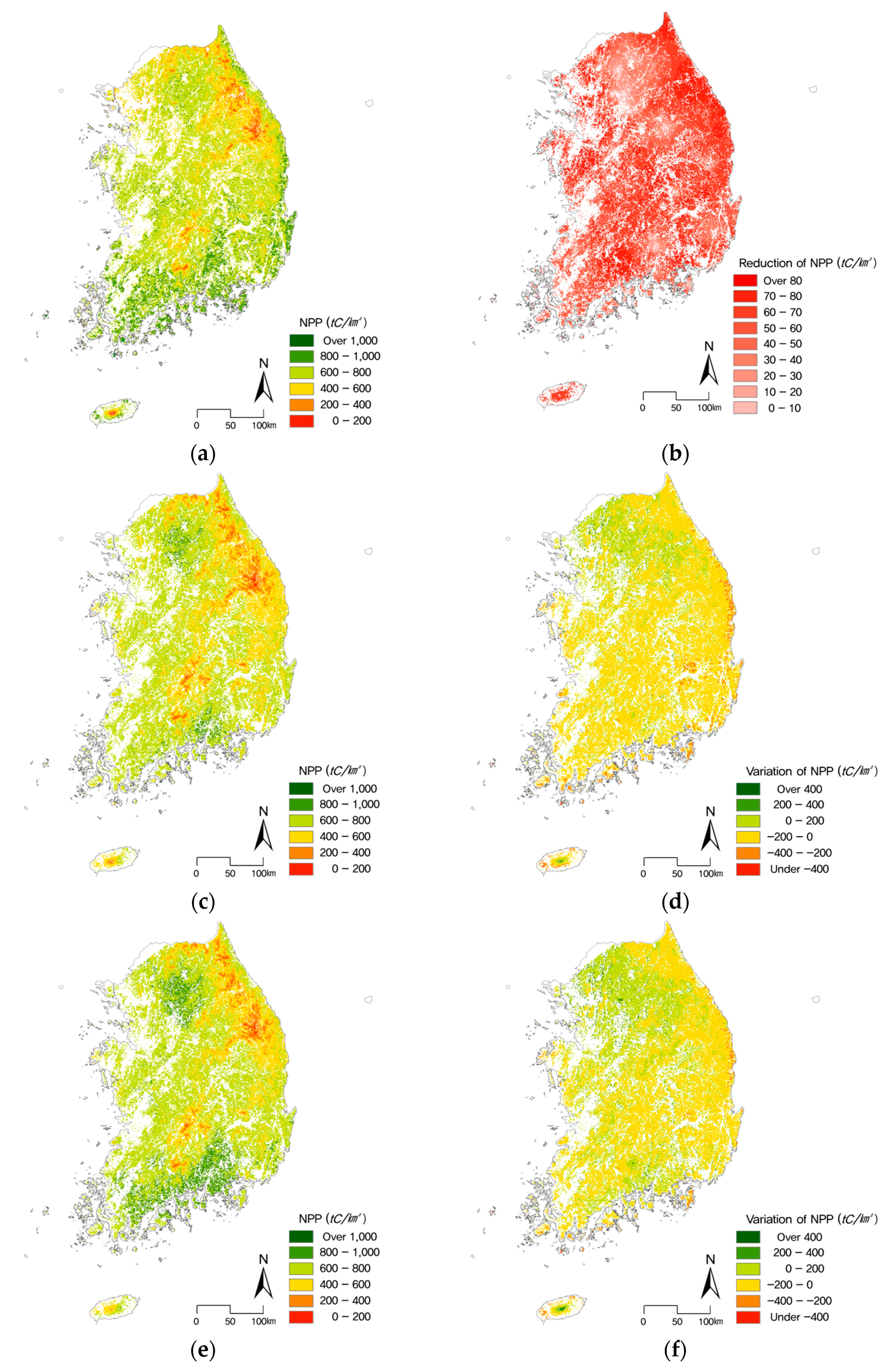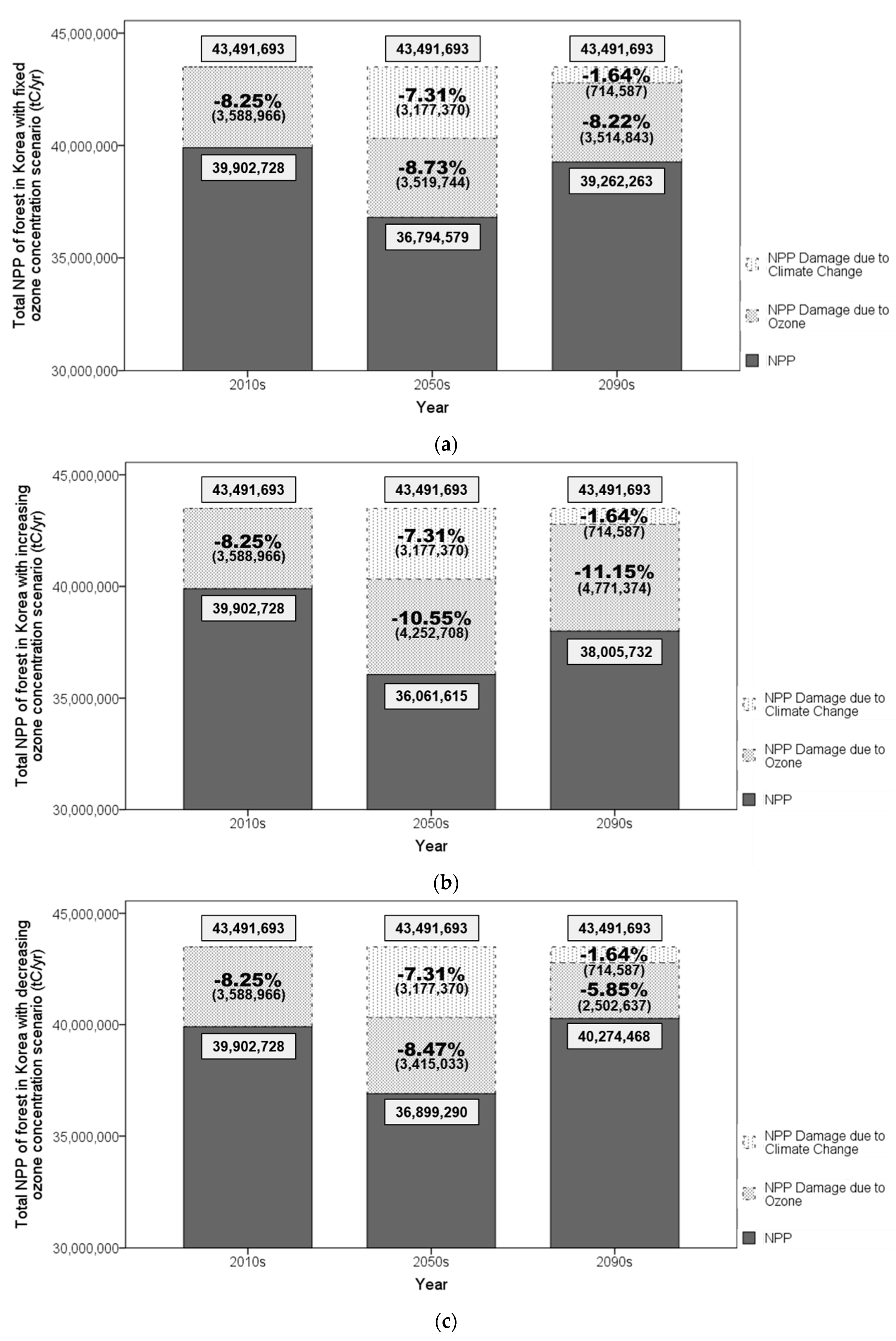3.1. Relationships between the Net Primary Productivity and Ozone Concentration
The Carnegie Ames Stanford Approach (CASA)-NPP values used in the model were developed using the 10-year average of 592.53 tC/km2/year (SD: 213.72 tC/km2/year); over the last decade the ozone concentration in the forest areas in the second and third quarters had a mean of 0.0867 ppm (SD 0.0395 ppm).
First, we estimated the future NDVI using a vector autoregressive model to reflect changes in vegetation over time, such as future forest distribution. The NDVI estimation model was developed using variables that affect vegetation activity. The independent variables used in the NDVI estimation model are the previous year’s NDVI, annual precipitation, and annual temperature range (
Table 2). The higher the NDVI value in the previous year, the higher the NDVI value in the year being observed. Higher annual precipitation and a higher annual temperature range lead to a higher NDVI value.
Second, we estimated the future NPP using a panel analysis model to reflect the ozone concentration. This is the result of panel analysis model selection before the panel analysis result. A one-way time and random effect model was selected as the most suitable panel analysis model among the various panel analysis models considered in this study. Specifically, we selected the time effect model of the one-way model through the Least Square Dummy Variable (R-sq.: 0.9746) and Chow-test (F-value: 70.63, Sig.: 0.000). Next, we determined that random effects model is more significant through the Breusch and Pagan Lagrangian Multiplier test (see
Table A2) and the Hausman test (see
Table A3). The Breusch and Pagan Lagrangian Multiplier test results showed that both of the models were significant, but the random effect model was chosen because the null hypothesis, where the difference in coefficients was not systematic, could not be rejected by Hausman test. Finally, one-way time and random effects models were selected by this process. Also, the rho value in context of the random effect model indicates the estimated proportion of the between variance at the total variance was about 0.86. In addition, the Durbin-Watson test value was 1.722, indicating that there was no time-series autocorrelation between each variable.
The independent variables used to develop the net primary productivity of the forest impact model when considering the effects of ozone are NDVI, solar radiation, altitude, and average concentration of ozone in the second and third quarters.
According to the results, NPP tends to increase, and NPP increases with increasing NDVI and solar radiation. However, as the altitude increased, NPP decreased, as shown in
Table 3. The concentration of ozone has a negative effect on NPP. The analysis suggests that the ozone concentration begin exerting effects to the NPP, about 68.10 tC/km
2/year decrement per 0.01 ppm increment. NDVI and previous year NDVI, annual precipitation, annual temperature range, solar radiation, altitude, and average ozone concentrations in the second and third quarters were found to have an impact on vegetation growth. The NPP estimation model, which reflects the effects of ozone, is shown in
Table 3.
The NDVI and the net primary productivity of forests estimates derived from the results are shown in
Figure 3.
Figure 3 shows the annual mean value of NDVI, the net primary productivity of forests used as input data, and the 10-year mean value in the future. The values of NDVI were about 0.58~0.61 and were within the range of the NDVI value of forest [
74]. The values of NDVI in this study are similar to the values that are found in other studies [
75]. The net primary productivity of forests for the last decade was about 630–696 tC/km
2/year, and the average NPP for the last 10 years was about 663 tC/km
2/year (SD: 21 tC/km
2/year). The average value of the total NPP of Korea is about 40 million tC/year. The year 2003 had the lowest NPP, at about 38 million tC/year, and the highest NPP value was about 42 million tC/year in 2009. The independent variables in 2003 showed that precipitation, NDVI, and temperature range were higher than in other years, but solar radiation was notably low. The low productivity in 2003 was due to this comparatively lower solar radiation. In addition, the NPP of forests was the highest in 2009 because of that year’s comparatively higher amount of solar radiation; precipitation and NDVI values were similar to those of other years, but the highest level of radiation was observed in 2009. Based on all of the available information, we concluded that the distribution of these input variables affected the results. Furthermore, both NPP and NDVI are expected to decrease in the 2050s, when compared to their current levels, and they are expected to increase in the 2090s compared to their 2050s levels. However, NDVI increases compared to its present level in the 2090s, but NPP is expected to decrease compared to its current level during the same period. This implies that NDVI estimation is related to variables such as temperature and precipitation, but it can be assumed that the change in ozone concentration influenced NPP estimation. However, the empirical model has a disadvantage in that it can be only applied to the region for model developing [
76], and there is a limitation that the actual technology is reflected [
41,
77].
3.2. Relationships among Climate Change, Ozone Concentration and the Net Primary Productivity of Forest
Figure 4 shows the differences and spatial distributions of the net primary productivity of forests with the effects of ozone at present and its variation due to ozone concentration and climate change. In
Figure 4, the net primary productivity of forests in the southern region is higher than that of the central region due to variables, such as temperature range, precipitation, and solar radiation, and the forest productivity in the central inland region is relatively higher than in the rest of the central region. This is because solar radiation and temperature have an influence on the distribution of the net primary productivity of forests [
78]; the forest region has a lower amount of solar radiation and lower temperatures than the central inland region, which is why it has a lower NPP than the inland region [
79]. Another study showed that carbon from 585 tC/km
2/year, to 731 tC/km
2/year is stored in vegetation every year, which is similar to the results of this study [
80].
Also, using the point data in the results, we examined the differences between forest type and region; the Kruskal-Wallis test was used to do this. The results showed that the net primary productivity of forests, NDVI, and ozone concentrations differed significantly by region. However, there was no difference between the two groups when they were classified using the same method. This is because the differences between forest types were reflected in the process of deriving the future variables of NDVI.
Figure 5 shows the result of the model derived in this study, which estimates the net primary productivity of forests when ozone concentration maintains its current level, when it increases to its maximum potential level, and when it decreases to its absolute lowest potential level. The current average net primary productivity of forests is about 40 million tC/year, which is about 36 million to 37 million tC/eayr in the 2050s and 38 million to 40 million tC/year in the 2090s. The net primary productivity of forests is expected to increase in the 2090s when compared to the net primary productivity in the 2050s due to an increase in temperature and precipitation. The results of this study show that adaptation policies are important for managing forest productivity in response to climate change. We can consider that adaptation policies may be more useful in forest policy because of the potential for increasing the net primary productivity of forests in future climate change scenarios because some variables will affect forest growth.
The damage that is caused by ozone to the net primary productivity of forests was as high as 27.07% in individual analysis units, with the average amount of damage when all the analysis units were analyzed measuring 9.08%. The total net primary productivity of forests in Korea was estimated to be about 43 million tC/year without the effects of ozone and about 40 million tC/year considering the ongoing effects of ozone accounting for the 10-year average. From 2001 to 2010, the NPP of forests decreased due to ozone by an average of about 8.25% in Korea. According to a study by Ollinger et al. [
43], the decrease in forest productivity due to ozone in the United States has decreased by at least 3% to 16%, an average of 7.4%, in 64 sites from 1987 to 1992, and Felzer et al. [
19] found that annual forest productivity decreased from 1987 to 1992 by 2.6 ± 0.34%. In particular, the average concentration of ozone during the second and third quarters, when NPP is in full swing, has the greatest impact. According to these studies that ozone influences NPP production at a mean concentration of 0.04 ppm or higher [
19,
43]. In fact, the concentration observed was about 0.05 ppm, indicating a concentration that influences NPP production. Damage also is expressed when contact is made between 0.06 ppm and 0.170 ppm for 4 h and between 0.200 ppm and 0.510 ppm for 1 h for susceptible species [
7]. In general, it is also known that after 20 days of exposure, yield is reduced by 50% in the case of radish at 0.05 ppm per 1 day, and carnations are affected by a decrease in flowering rate and a decrease in the production of pollen.
In the future, ozone concentration changes due to nitrogen oxide emissions from various scenario combinations are expected to decrease by up to between 3% and 21% when compared to current levels in the 2050s and between 29% or 36% in the 2090s (see
Figure 2 in
Section 2.2.3). Changes in the net primary productivity of forests due to ozone concentration change scenarios are shown in
Figure 5. When average ozone concentration decreases by about 3% in the 2050s, the net primary productivity of forests increases by about 0.28%. When the average ozone concentration increases by about 21%, the productivity of the net primary productivity of forests decreases by about 1.99%. In the 2090s, when the average ozone concentration decreases by about 29%, the net primary productivity of forests increases by 2.58%, and when the ozone concentration increases by about 36%, the net primary productivity decreases by about 3.20%. Under the RCP 8.5 scenario, an increase in ozone and its impact on vegetation is simulated in Asia, where a strong decrease in NPP (1.0–1.5% per year) was simulated [
15,
81,
82]. A reduction of the ozone impact on vegetation is observed in particular over the Eastern US and in Southeastern China by 2100 [
15]. A study evaluated the effects of tropospheric ozone on GPP at 37 European forest sites during the time period 2000–2010 and showed, along a North-West/South-East European transect, a negative impact of ozone on GPP, ranging from 0.4% to 30% [
83].
The results obtained from predicting the damage caused by ozone are different from the results of the impact assessment of climate change. The net primary productivity of forests due to climate change may increase with management or adaptation policies, but damage from ozone results in a decrease in productivity as the concentration of ozone increases. These results show that mitigation policies are important to reduce the negative impact of ozone on net primary productivity of forests. Reducing nitrogen oxide emissions and decreasing the concentration of ozone generated, thereby will also reduce the damage to forest productivity.










